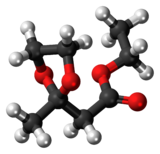
| |

| |
| Names | |
|---|---|
| Preferred IUPAC name
Ethyl (2-methyl-1,3-dioxolan-2-yl)acetate | |
| Other names
Ethyl 2-(2-methyl-1,3-dioxolan-2-yl)acetate
| |
| Identifiers | |
3D model (JSmol)
|
|
| ChemSpider | |
| ECHA InfoCard | 100.026.467 |
| EC Number |
|
PubChem CID
|
|
| UNII | |
CompTox Dashboard (EPA)
|
|
| |
| |
| Properties | |
| C8H14O4 | |
| Molar mass | 174.19 |
| Appearance | Clear liquid |
| Density | 1.067 g/cm3 (1) |
| Boiling point | 207.99 (760 mmHg) |
| 1.893 g/L | |
| Hazards | |
| Flash point | 97 °C (207 °F; 370 K) |
Except where otherwise noted, data are given for materials in their standard state (at 25 °C [77 °F], 100 kPa).
| |
Fructone is the organic compound with the formula CH3C(O2C2H4)CH2CO2C2H5 It is the ketal derived from the condensation of ethyl acetoacetate and ethylene glycol. Also known as apple ketal and applinal, is has a fruity, apple-like smell with pineapple, strawberry, and woody aspects reminiscent of pine trees. It is a commercial fragrance.[1]
External links[edit]
- Fructone product page[permanent dead link] IFF
- Extensive data page, including 3D chemical structure applet
References[edit]
- ^ Panten, Johannes; Surburg, Horst (2016). "Flavors and Fragrances, 3. Aromatic and Heterocyclic Compounds". Ullmann's Encyclopedia of Industrial Chemistry. pp. 1–45. doi:10.1002/14356007.t11_t02. ISBN 978-3-527-30673-2.
Well, that’s interesting to know that Psilotum nudum are known as whisk ferns. Psilotum nudum is the commoner species of the two. While the P. flaccidum is a rare species and is found in the tropical islands. Both the species are usually epiphytic in habit and grow upon tree ferns. These species may also be terrestrial and grow in humus or in the crevices of the rocks.
View the detailed Guide of Psilotum nudum: Detailed Study Of Psilotum Nudum (Whisk Fern), Classification, Anatomy, Reproduction